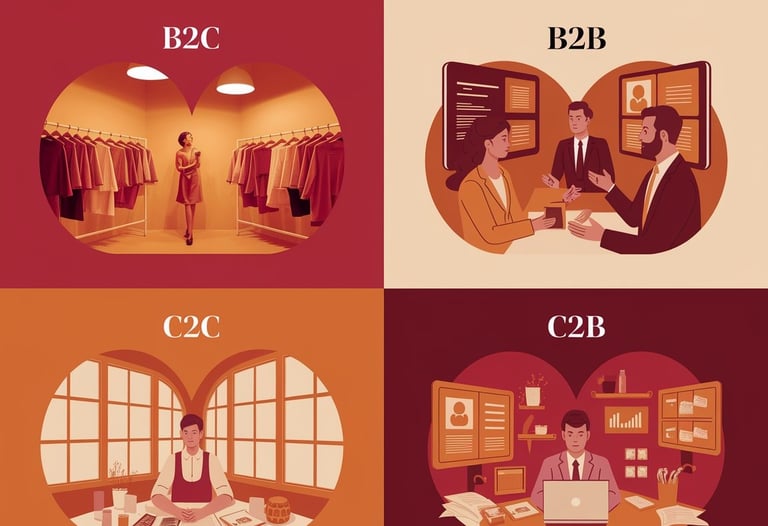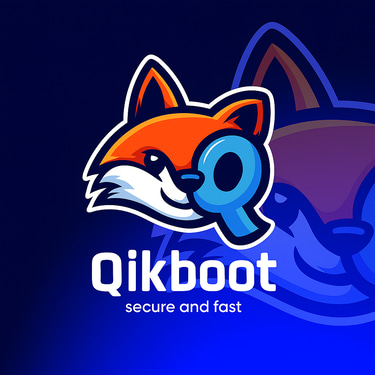Drive Revenue Up with Qikboot Growth Strategies
What Is E-Commerce? A Beginner's Guide
Explore what e-commerce is, its types, benefits, and how it works. This blog simplifies all the topics beginners need to know about e-commerce.
3/4/202511 min read
Do you actually know or understand what e-commerce means? In general, e-commerce means buying and selling goods or services online. Shopping online means ordering things like clothes from Amazon or groceries from BigBasket.
Before starting an e-commerce business, you need to grasp what e-commerce is. Why is it so? Because the way we shop has changed and will change forever. Today, more people like shopping online. They enjoy the convenience and variety that online stores offer over local markets.
In this blog, you will learn what e-commerce is, its types, benefits, and how it works. Whether you're a curious shopper or planning to start your own online business, you will learn it all by the end of it!
What is e-commerce?
E-commerce refers to the buying and selling of goods or services through the internet. E-commerce happens on digital platforms. Traditional commerce, however, takes place in physical stores. Customers can browse, choose, and pay for products online. They do this through websites or apps, all from home.
Think of popular platforms like Amazon, Flipkart, or Shopify. These are great examples of e-commerce sites. Millions of transactions happen online every day.
Types of E-Commerce
E-commerce isn't one size fits all. It comes in different forms depending on who is selling and who is buying. Regardless of your business type, it's important to understand e-commerce types. You never know where growth may lead you. Here is a clearer and deeper look at the four main types of e-commerce:
1. Business-to-Consumer (B2C)
B2C e-commerce occurs when businesses sell products or services to individual consumers. This is like shopping at your favorite store, but it happens online. It’s the most common type, and most people are already familiar with it. In this model, businesses set up online stores or apps. Consumers then browse, pick products, and buy. Great examples include Amazon, where you can buy anything from books to electronics. Then there's Walmart, where you can find groceries and household essentials.
2. Business-to-Business (B2B)
In B2B e-commerce, businesses sell to other businesses. They do not sell to individual customers. These transactions are usually bigger and happen more often. They often need more negotiation or involve bulk buys. In this model, businesses post bulk products or services online. Other businesses buy these goods, often in large amounts, for resale or their own use. Examples include Alibaba, where global companies buy bulk goods at wholesale prices. IndiaMART helps Indian businesses find equipment, machinery, and raw materials straight from suppliers.
3. Consumer-to-Consumer (C2C)
C2C e-commerce involves individuals selling products or services to other individuals online. Imagine a digital garage sale. It's a place where everyday people can buy and sell used, handmade, or one-of-a-kind items. In this model, people list items they want to sell. Others can browse these listings and buy. Some popular examples are eBay. On eBay, people can auction or sell personal items. This includes collectibles and gadgets. You can also use Facebook Marketplace. It’s a place where locals sell furniture and cars to nearby buyers.
4. Consumer-to-Business (C2B)
In C2B e-commerce, individual consumers offer products or services to businesses. This flips the usual model. Now, people can offer their skills, knowledge, or products to companies that want them. In this model, people display their skills or products online. Businesses buy these services or products for their operations, marketing, or projects. An example is Upwork. Freelancers there offer services like writing, graphic design, and programming. Businesses can hire them for these tasks.
How does e-commerce work?
E-commerce might seem complicated, but it follows simple and easy-to-understand steps. We have broken down exactly how online shopping works for you—step by step.
1. Online Store Creation
The first step in e-commerce is setting up an online store or website. It's like creating a digital store. Customers can visit and browse products anytime. You have to choose an e-commerce platform such as Shopify, WooCommerce, or BigCommerce. These platforms offer templates, payment options, and inventory tools. This makes it easy for beginners. You can customize your online store. Add branding, images, and product categories. Don’t forget important pages like "About Us," "Contact," and "FAQ."
2. Product Listing
Once the store is set up, almost all businesses list their products or services online. This is like arranging items on shelves in a physical store, but in a digital format. You upload clear photos, detailed descriptions, prices, and inventory information. Good product listings have:
Titles
Specifications (size, color, materials)
Customer reviews
Content optimized for search engines appears on product pages. This helps customers locate products on search engines like Google with minimal effort.
Tips for Product Listings
Use high-quality images from multiple angles.
Write simple, but informative descriptions.
Add relevant keywords to improve search visibility.
3. Shopping Cart
The shopping cart is an essential e-commerce feature, like a digital basket. Customers use it to collect items they plan to buy. As customers browse your store, they click "Add to Cart" on products they like. The cart tracks selected items and their quantities. It also calculates the total cost, which includes taxes and shipping fees. Customers can review, change quantities, remove items, or apply discount codes here.
Key Features of a Good Cart
Easy to add or remove items.
Clear display of the total price, including taxes and shipping.
Option to save items for later or add coupons/discounts.
4. Checkout and Payment
The checkout process is when customers complete their purchases. They make payments through a secure online system. Customers enter their shipping address and contact details. They also select their preferred delivery method. Next, they pick a payment method. You can use credit or debit cards, digital wallets like PayPal or Google Pay, or bank transfers. You can choose secure payment gateways like Stripe or PayPal. They process transactions with care. They also protect sensitive data like credit card numbers.
5. Shipping & Delivery
After successful payment, we pack and ship products directly to customers' provided addresses. Once you confirm an order, you receive a notification to prepare and package the items. After this, we send products via courier services (e.g., FedEx, DHL, Shiprocket). Customers usually receive tracking information to track their delivery status in real time.
Important Considerations
Provide clear shipping policies and estimated delivery dates.
Offer many delivery options (standard, express, international).
Make the return process easy in case customers need exchanges or refunds.
What Are the Benefits of E-Commerce?
E-commerce has many strong benefits. These advantages help explain why online shopping and selling are becoming more popular. It allows customers to shop anytime, anywhere. Whether you're at home, in the office, or traveling, you can browse products online 24/7. There's no need to travel to physical stores, deal with crowded malls, or wait in long lines. You can compare prices, products, and reviews with a few clicks.
Picture ordering groceries or clothes at midnight. They arrive at your door the next day. This saves you time and energy. Keep reading to discover more benefits of e-commerce. You can gain these through thoughtful choices and smart strategies.
1. Global Reach
E-commerce allows you to sell beyond local markets, reaching customers worldwide. Your online store isn't tied to one place. This lets you reach customers in other cities, states, or even countries. This means you can tap into markets that would be impossible to reach with a physical store. A handmade jewelry business in India can reach customers in the USA, Europe, and Australia. They can use platforms like Etsy or their own website.
2. Cost Savings
Running an e-commerce store involves lower overhead costs compared to physical stores. You save on rent, utilities, and staff costs. This helps you start your business with a smaller investment. You don’t need costly retail space or high utility bills. Plus, managing inventory usually needs fewer employees. An online fashion brand can keep prices low. It saves money by not having costly physical stores.
3. Personalization
E-commerce allows you to use data to personalize customer experiences. You can suggest products. You can customize promotions. Or you can send messages based on what customers like and buy. Personalization improves customer satisfaction and loyalty, leading to increased sales and repeat purchases. Amazon shows "Recommended Products" based on your past browsing and purchases. This makes shopping feel personalized for you.
4. Faster Transactions
E-commerce facilitates instant payment processing, making transactions fast, smooth, and secure. Payments occur in seconds, making the buying process quick and hassle-free. Customers can check out fast, avoiding long lines. Secure online payment gateways ensure transactions are safe. Using digital wallets like PayPal or Google Pay allows customers to pay with a click. Online shopping is simpler now. It removes barriers that can prevent purchases.
What challenges can you face in e-commerce?
E-commerce has great benefits, but it also brings challenges. Businesses need to understand and manage these issues well. Among the biggest challenges in e-commerce are intense competition. With millions of online sellers worldwide, standing out can be tough.
This challenge hits small and new companies the hardest. To stand out, you need unique products. Also, use effective marketing strategies and provide great customer service. This will help you beat the many competitors. We are listing a few more e-commerce challenges for your better understanding:
1. Security
Security is a major concern in e-commerce due to the risks of online payment fraud and data breaches. Customers provide sensitive information like credit card numbers, addresses, and personal details. Protecting this information is important. Invest in secure payment gateways, encryption, and strong cybersecurity. This builds trust and ensures safe transactions. A security lapse can hurt a brand’s reputation and shake customer trust.
2. Logistics
Managing logistics, including shipping and returns, poses a big challenge for e-commerce businesses. On-time and accurate delivery is crucial. Yet, delays, lost packages, or damaged goods can upset customers. Managing returns and exchanges without complications holds the same level of importance. Efficient logistics systems and reliable shipping partners are essential to overcoming these issues. Small businesses often find shipping costs and complexities challenging. This is true whether they ship across the country or around the globe.
3. Customer Trust
Gaining customer trust in e-commerce can be tough. This is due to the lack of a physical presence. Online shopping doesn't let customers touch, feel, or try products before buying. This is different from shopping in physical stores. Trust builds through product reviews, clear policies, good communication, and reliable support. Product descriptions should be clear. Good images matter, too. Easy return policies also help. These things build customer trust over time.
What do you need to start e-commerce?
Starting an e-commerce business is easier with the right tools and platforms. Here’s a quick look at the main areas to help you build, run, and grow your online store.
1. Platforms
E-commerce platforms are essential tools for setting up your online store. They offer simple tools to build and manage your website. You can list products and handle orders.
Popular platforms are:
Shopify: It's simple and has strong built-in features.
WooCommerce: This WordPress plugin is customizable for flexible designs.
BigCommerce: Great for larger businesses with complex needs.
These platforms make it easy to create websites. Now, even beginners can launch their projects in a short amount of time.
2. Payment Gateways
Secure payment gateways are crucial for accepting payments online without risk. They process transactions and protect sensitive customer data.
Popular choices include:
PayPal: Trusted worldwide and easy to integrate.
Stripe: Smooth credit card processing and reliable.
Razorpay is popular in India for seamless local and international transactions.
These gateways allow customers to make secure payments. This builds trust and lowers cart abandonment rates.
3. Marketing Tools
Marketing tools help drive traffic, track performance, and convert visitors into customers.
Essential tools include:
Google Analytics gives insights into visitor behavior and site performance.
Facebook Ads are great for targeted advertising on social media.
Email marketing tools like Mailchimp and Klaviyo help businesses connect with customers. They make it easy to share promotions and build strong relationships.
4. Shipping Solutions
Efficient shipping solutions are vital for managing logistics, including packing, delivery, and returns. ShipStation makes order fulfillment easy with quick label printing and tracking. People know FedEx for dependable shipping, both in the U.S. and worldwide. In India, customers favor Shiprocket for its affordable delivery services. These tools simplify logistics management, ensuring timely delivery and improved customer satisfaction.
What can beginners do?
When starting an e-commerce business, it's wise to begin small. Focus on a few products or a niche market first. This method helps you use resources well. It lets you test ideas and find out what works best. As your business grows, learn more about your customers. Expand your product range, inventory, or marketing efforts in stages. Scaling at a gradual pace prevents overwhelming yourself and ensures sustainable growth.
Providing an excellent customer experience is important in e-commerce. Your website needs to be easy to use. It should have simple navigation, clear product descriptions, and high-quality images.
Pro Tips
Answer customer questions with efficiency.
Offer easy returns.
Encourage feedback and reviews.
Happy customers come back and tell others about your store. This helps build loyalty and trust in your brand. Social media is a powerful tool for beginners to attract and engage customers. Platforms like Instagram, Facebook, Pinterest, and TikTok showcase your products. They also share engaging content and help you reach a wider audience. Share appealing images, helpful tips, and promotions. Also, engage with followers. Social media marketing is affordable. It also helps create a loyal community for your brand.
Most online shopping happens on mobile devices today, making mobile optimization essential. Make sure your website loads fast. It should work well on smartphones and tablets. Also, it must be easy to navigate. Test your checkout process in detail on mobile devices. A smooth mobile experience lowers cart abandonment. It also keeps customers happy, which boosts conversions.
Security is a priority in e-commerce, especially during checkout. Use trusted payment gateways such as PayPal, Stripe, or Razorpay. They help keep customers' payment information safe. Tell customers about your site's security measures, like SSL certificates (https://). This helps reassure them. A secure and simple checkout builds trust. It encourages purchases and lowers the risk of fraud or data breaches.
Future of E-Commerce
E-commerce is evolving in response to changes in technology and consumer expectations. Knowing future trends helps businesses stay competitive and ready for what's next. Here are key trends shaping the future of e-commerce:
1. Mobile, voice, and AI commerce
The future of e-commerce has a strong connection to technology. Mobile commerce is growing. More customers shop on smartphones, so they want sites that are easy to use and load fast. A big trend now is AI-driven personalization. It uses artificial intelligence to create tailored shopping experiences. This means customers see exactly what they want based on their past behavior. Voice commerce will grow thanks to virtual assistants like Alexa and Google Assistant. This will make shopping as easy as speaking a command.
2. Seamless Customer Experience
In the future, providing a smooth customer experience will be vital. Customers expect easy, smooth, and quick online interactions from browsing to checkout. Businesses should have websites that are easy to use. They must also provide good customer support, quick delivery, and simple return processes. Any friction, delay, or complexity in the buying process could drive customers away. To succeed in e-commerce, keep the customer experience smooth and improve it.
3. More businesses are moving online.
More businesses are moving online due to shifting consumer preferences and global trends. The pandemic sped up the digital shift. It showed companies that having an online presence is crucial. Even traditional businesses now see e-commerce as essential for survival and growth. Online competition will increase. But new opportunities will emerge as more customers shop online. Adopting online strategies early helps businesses stand out in the changing market.
What is the next step?
In this beginner’s blog, we together explored what e-commerce is and how it works. We learned about different types, like B2C, B2B, C2C, and C2B. We also saw its benefits: convenience, global reach, and cost savings. We talked about common challenges, such as competition and logistics. We discussed key tools and platforms that simplify starting an e-commerce business. Finally, we looked ahead to the thrilling future of e-commerce. Mobile shopping, AI personalization, and smooth customer experiences will lead the way.
Now is a great time to explore e-commerce. You can start a new business or grow an existing one. The online marketplace keeps growing. It offers many chances for success, innovation, and growth. Take these chances, stay updated, and get ready to succeed in this changing industry.








